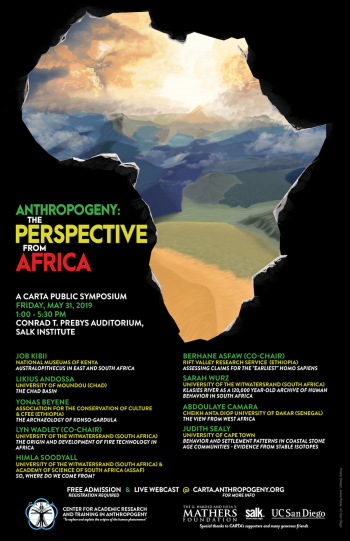Anthropogeny: The Perspective from Africa
Berhane Asfaw, National Museum of Ethiopia
Lyn Wadley, University of the Witwatersrand
Summary:
Darwin and Huxley first predicted that we humans shared a common ancestor with the African great apes and it is now abundantly clear that Africa was the “cradle of humanity,” with multiple waves of hominins arising on that continent and spreading across the old world, eventually being effectively displaced by our own species, which also arose in Africa. As Svante Paabo put it, “we are all Africans, either living in Africa or in recent exile from Africa." Given these facts, it is not surprising that the strong emphasis of anthropogeny is on the continent of Africa with studies ranging from genetic to paleontological to archeological to primatological to climatological to sociocultural. This CARTA symposium focuses on the contributions of scientists and scholars of anthropogeny who live and work in Africa.
Media for each talk can be played by clicking on icons in the table below, or by clicking on the individual talk titles below and then the attachment file at the bottom of the page.
| Speakers | Media | Session |
|---|---|---|
 Margaret Schoeninger  Berhane Asfaw |
|
Welcome & Opening Remarks |
 Job Kibii |
|
Australopithecus in East and South Africa Australopithecus is a genus of hominins whose evolutionary evidence is confined to the African continent. The genus evolved in eastern and/or southern Africa around 4 million years ago, eventually becoming extinct slightly less than two million years ago. Australopithecus is scientifically accepted as the common ancestor of the Paranthropus and Homo. Scientists recognize five species of Australopithecines; Australopithecus anamensis, A. afarensis, A. africanus, A. garhi, and A. sediba. Their... read more |
 Likius Andossa |
|
The Chad Basin Until recently, Chad has remained a poorly known country as far as paleontological research, compared to its neighbors on the African continent. But since 1994, the Mission Paléoanthropologique Franco-Chadienne (MPFT) is conducting intensive geological and paleontological surveys in the Djurab desert. More than 400 Mio-Pliocene fossil sites dated between ca 3 and 7 Ma have been identified. These sites have yielded rich and diverse fossil faunal assemblages of vertebrates, unique in Central... read more |
 Yonas Beyene |
|
The Archaeology of Konso-Gardula Early Pleistocene archaeological sites of East Africa have provided us with a wealth of data that is unparalleled anywhere else. The earliest Oldowan and Acheulean industries have been respectively dated to circum 2.6 Ma and 1.75 Ma. The “transition” between the Oldowan and Acheulean technologies and the dynamics that are associated with it are addressed through paleontological and paleoecological studies. At Konso, both Homo erectus and Australopithecus boisei remains are found at the circum 1... read more |
 Lyn Wadley |
|
The Origin and Development of Fire Technology in Africa Fire has traditionally provided humans with light, warmth, social comfort, protection from predators, and the ability to cook and process a variety of useful products. When did humans first recognise the advantages rather than the dangers of fire? When did people learn to control and reproduce fire instead of using it expediently? Sophisticated fire technology was known to Homo sapiens, but archaeological evidence implies that fire could be used at will by hominins in Africa long before modern... read more |
 Himla Soodyall |
|
So, Where Do We Come From? People are interested in knowing their family origins. However, very few people know their family history, and even those who can access genealogical information, usually trace their family history to a few generations. In South Africa, tracing one’s ancestry is even more problematic due to poor family record keeping, the way surnames were given to people who were enslaved, cultural practices of how surnames are transmitted, among other issues. My research on the genetic prehistory of the... read more |
 Berhane Asfaw |
|
Assessing Claims for the “Earliest” Homo sapiens The definition of Homo sapiens has been a matter of debate among researchers in human evolution for centuries. Recently, a qualifier has been added to the species name, “modern”. This addition denotes that there are some Homo sapiens who are not modern. This explains that the species we are dealing with is an evolving species lineage and we are therefore arbitrarily naming a segment of this evolving lineage as “modern” Homo sapiens. The fossil record for all hominins is very incomplete. As we... read more |
 Sarah Wurz |
|
Klasies River as a 120,000-Year-Old Archive of Human Behavior in South Africa Klasies River main site was a favored home base for southern Cape humans between 120 000 and 2300 years ago, leading to the build-up of more than 21 meters of superimposed shell middens. The fossils of early modern humans preserved within the deposits provide a unique glimpse into the appearance of human ancestors from the southern Cape coast and on aspects of their behavior. The extensive midden deposits show that hunter-gatherer-fisher groups visited the site throughout the climatic and... read more |
 Abdoulaye Camara |
|
The View from West Africa In terms of discoveries of human palaeontology and prehistory, West Africa seems to be the “poor relative”. No hominid anterior to our species has yet been found; only stone tools have been discovered, the only witnesses of an old settlement of this part of the continent. The oldest lithic industries are included or related to Quaternary levels of the Middle Pleistocene. Some researchers have attributed to Oldowan culture to some pebbles discovered in unstratified levels, others have claimed ... read more |
 Judith Sealy |
|
Behavior and Settlement Patterns in Coastal Stone Age Communities – Evidence from Stable Isotopes Coastlines offer rich resources for hunter-gatherers: abundant food, raw materials for making artefacts, possible routes for dispersal and much more. Were coastal areas therefore important in human evolution? Opinions have gone back and forth over the years. In the second half of the twentieth century, most researchers thought that aquatic resources became important late in prehistory, once populations had grown so that additional sources of food were needed. Today, different perspectives are... read more |
 Lyn Wadley  All Speakers  Ajit Varki |
|
Wrap-up, Question and Answer Session, Closing Remarks |
| Attachment | Size |
|---|---|
| 476.54 KB | |
| 109.07 KB | |
| 333.2 KB | |
| 216.65 KB | |
| 579.06 KB | |
| 828.73 KB |
If you enjoy this event, please consider supporting CARTA's quest to explore and explain the human phenomenon.


